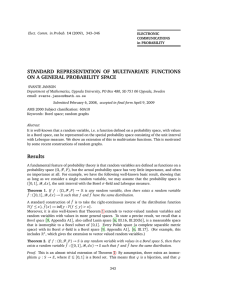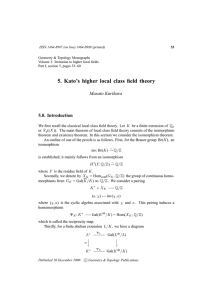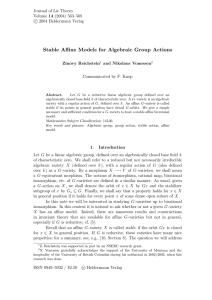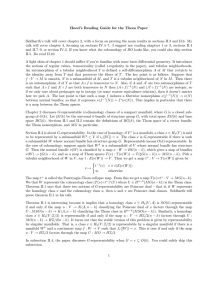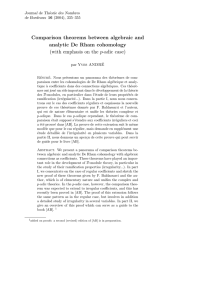Geometric aspects of algebraic cobordism 21 Mar 2014
advertisement
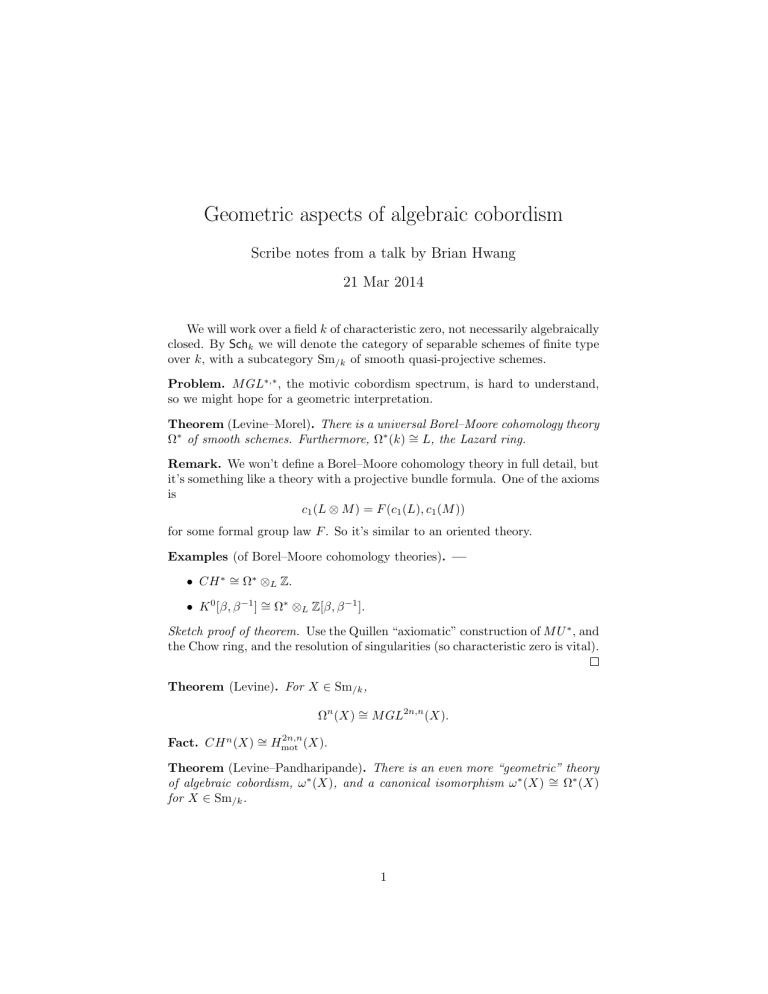
Geometric aspects of algebraic cobordism Scribe notes from a talk by Brian Hwang 21 Mar 2014 We will work over a field k of characteristic zero, not necessarily algebraically closed. By Schk we will denote the category of separable schemes of finite type over k, with a subcategory Sm/k of smooth quasi-projective schemes. Problem. M GL∗,∗ , the motivic cobordism spectrum, is hard to understand, so we might hope for a geometric interpretation. Theorem (Levine–Morel). There is a universal Borel–Moore cohomology theory Ω∗ of smooth schemes. Furthermore, Ω∗ (k) ∼ = L, the Lazard ring. Remark. We won’t define a Borel–Moore cohomology theory in full detail, but it’s something like a theory with a projective bundle formula. One of the axioms is c1 (L ⊗ M ) = F (c1 (L), c1 (M )) for some formal group law F . So it’s similar to an oriented theory. Examples (of Borel–Moore cohomology theories). — • CH ∗ ∼ = Ω∗ ⊗L Z. • K 0 [β, β −1 ] ∼ = Ω∗ ⊗L Z[β, β −1 ]. Sketch proof of theorem. Use the Quillen “axiomatic” construction of M U ∗ , and the Chow ring, and the resolution of singularities (so characteristic zero is vital). Theorem (Levine). For X ∈ Sm/k , Ωn (X) ∼ = M GL2n,n (X). 2n,n Fact. CH n (X) ∼ = Hmot (X). Theorem (Levine–Pandharipande). There is an even more “geometric” theory of algebraic cobordism, ω ∗ (X), and a canonical isomorphism ω ∗ (X) ∼ = Ω∗ (X) for X ∈ Sm/k . 1 Constructing ω(X) Geometrically we think of cobordism theory in terms of cobordisms: Question. How can we algebraize this? We’ll try families of algebraic varieties over P1 : 0 ∞ Idea (Naive). For projective morphisms π : Y → P1 , impose the “naive cobordism relation” [π −1 (0)] = [π −1 (∞)]. But this resulting ring doesn’t look like complex coordism. For instance, even if X = Spec k, with k algebraically closed, and even for dimension 1 objects Y , this relation is not enough (if Cg is a curve of genus g > 0, Cg 6∼ (1 − g)P1 ). Idea. Impose relations obtained by fibers of π with normal crossing singularities. Surprisingly, if we impose relations given by the simplest such case, namely double point degeneracies, we recover Ω∗ . Definition. Let Xi ∈ Sm/k . X0 X3 0 X1 X2 ∞ We call [X0 ] = [X1 ] + [X2 ] − [X3 ] a double-point relation if there exists a family X such that 2 (1) X0 is a smooth fiber over 0, (2) the fiber over ∞ has two components X1 and X2 , (3) X1 and X2 intersect transversely along a smooth divisor D, (4) X3 ∼ = PD (NX/D ⊕ OD ) ∼ = PD (Od ⊕ NX2 /D ). Note that the case X2 = ∅ recovers the naive cobordism relation. Theorem. ω∗ (X) = h proj. f : Y → X | Y irred i/DPR This is exciting because it means all X ∈ Sm/k can be linked to products of Pn s by the following results. Theorem. There exists a canonical isomorphism ω∗ (X) ∼ = Ω∗ (X). Proof. — (⇒) This is easy, just show that the DPRs hold in Ω∗ (X). (⇐) Trickier. We have to check axioms that ω∗ is a “B–M functor of geometric type”. Corollary. ω∗ (C) ⊗Z Q = M Q[Pλ1 × . . . × Pλ`(λ) ] partitions λ Example. If [Y ] ∈ ω3 (Q)Q , for any r ∈ Z, r[Y ] = s3 [P3 ] + s21 [P2 × P1 ] + s111 [P1 × P1 × P1 ] ∈ ω∗ (C), for some sλ ∈ Z. If Z is the partition function of degree 0 Donaldson–Thomas invariants (this is a rational power series), we have Y Z(Y, q)r = Z(Pλ , q)sλ . |λ|=3 Example. Gromov–Witten theory “equals” Donaldson–Thomas theory, in the sense that their partition functions agree up to change in coordinates. This holds for all toric 3-folds over C. Question. Gromov–Witten theory is usually phrased in a symplectic context. What kind of symplectic cobordism theory corresponds to ω∗ and the DPRs? Remark. — 3 • Ω∗ (X) is easy for cellular varieties. • Additive structure is given by the free Ω∗ (X) is like a Chow group. ` -module on cells, so additively • We have a ring homomorphism Ω∗ (X) → M U 2∗ (X(C)an ). If X is cellular then this is an isomorphism. Problem. Computations in Ω∗ (X) currently only seem to apply well if they were done by algebro-geometric methods (e.g. blow-ups). Using the structure of M U ∗ (X(C)an ) seems difficult, especially if the structural results were gained using topological methods with no algebraic analogue. Theorem. Ωn (X) ∼ = M GL2n,n (X). Sketch proof. — 1. Prove the result for function fields of smooth varieties. 2. Induct on the dimension of X, using localization sequences for Ω∗ and the description of their connecting homomorphisms. If X = Spec(F ), where F is a finitely generated field over k, then a E2p,q (n) = H p−q,n−q (F ) ⊗ q ⇒ M GLp+q,n . Use this to show that ϑM GL (X) : Ω∗ (X) → M GL2∗,∗ (X) is surjective, and then given σ : F ,→ C, we have a natural transformation ϑM U,σ (X) : Ω∗ (X) → M U 2∗ (X(C)) and we have a commutative diagram Ω∗ (X) ϑM GL (X) ∼ = M U,σ M GL2∗,∗ (X) Reσ (X) ϑ M U 2∗ (X(C)) 4







